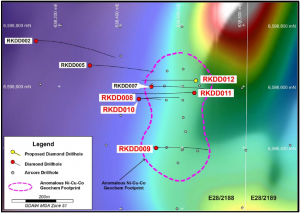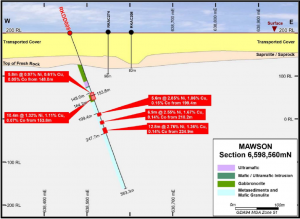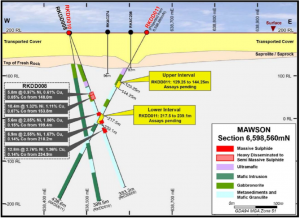Legend Mining – (ASX: LEG, Share Price: $0.195, Market Cap: $429m, coverage initiated @ $0.011 in Sep 2015 – current gain of 1672%)

Key Catalyst
March quarter drilling produces spectacular exploration results from Mawson prospect, material widths and the grades in hole RKDD008, whilst assays are awaited from hole RKDD011.
LEG has performed strongly since our coverage initiation at $0.011 in late 2015, although like most junior explorers there’s been plenty of volatility along the way. It can be argued LEG’s exploration results from its Mawson prospect in Western Australia’s Fraser Range province are the most significant since the discovery of the world-class Nova-Bollinger nickel-copper deposits by Sirius Resources. The Nova-Bollinger discoveries ultimately led to a $1.8 billion takeover of Sirius by Independence Group (ASX: IGO) in late 2015, a far cry from Sirius’ micro-cap status a few years earlier. LEG happens to be one of the last independent ASX-listed juniors properly focused on the region, with the added benefit of a strategic shareholding by Australia’s most successful prospector, Mark Creasy, a major player in the Fraser Range province. LEG’s latest drilling program at Mawson has generated the most exciting results so far.
Latest Activity
Rockford Project Update
Overview
The March 2020 quarter has produced spectacular exploration results from LEG’s Mawson prospect, which has in turn has generated significant share price appreciation. The widths and the grades of the nickel-copper sulphide intercepts in hole RKDD008 are material. Whilst assays are awaited from hole RKDD011, the same can be said of the widths of the intercepts.

Figure 1: Mawson Diamond Drill-hole Locations on Aeromagnetics
Analysis
Exploration activities completed at Rockford during the March 2020 comprised diamond drilling and down-hole electromagnetic (DHTEM) surveying at Mawson, along with the commencement of air-core drilling at Mawson.
So far at Mawson, four diamond drill-holes have been completed at Mawson, comprising RKDD 008-011 for a total of 1,578.4m. The initial drilling in hole RKDD008 was designed to follow up the significant nickel-copper sulphide mineralisation that was intersected in drill-hole RKDD007, along with the and anomalous nickel-copper geochemistry that was intersected in previous air-core drill-holes. Subsequent drilling has been designed to follow up the massive sulphide mineralisation identified in hole RKDD008, as well as to target identified off-hole downhole electromagnetic (DHTEM) conductors.
Diamond drill-hole RKDD008 was designed to test a strong 6,000-8,000S off-hole conductor identified by downhole electromagnetic (DHTEM) surveying in RKDD007. This off-hole feature was interpreted to represent the down plunge extension of significant nickel-copper sulphide mineralisation previously identified in RKDD007 (14.9m @ 1.07% Ni, 0.75% Cu, 0.06% Co from 114m).
RKDD008 intersected five significant intervals of nickel-copper sulphide mineralisation, three of which comprise massive sulphides of pyrrhotite-chalcopyrite-pentlandite. In all, RKDD008 intersected 41.5m of nickel-copper sulphides – including 25m of massive sulphide – with peak assay values of 3.03% nickel, 3.86% copper and 0.16% cobalt.

Figure 2: RKDD008 Drill Section 6,598,560N – showing geology and the location of the five sulphide intervals
Another significant hole drilled so far has been RKDD011, which was designed to test for extensions to the sulphide mineralisation intersected in adjacent drill-holes RKDD007 and RKDD008, and also test a strong 50,000-60,000S DHTEM conductor identified from surveying in RKDD010.
RKDD011 encouragingly intersected two broad intervals of nickel-copper sulphide mineralisation – the upper interval contains multiple thin/localised units of vein, breccia, disseminated and semi-massive sulphide hosted in mafic/ultramafic intrusive – while the lower interval contains three intercepts of massive pyrrhotite-chalcopyrite-pentlandite. These mineralised intervals are visually similar to those observed in RKDD008 and have a combined downhole thickness of 36.6m.
Sampling of the RKDD011 drill core for assay has not been undertaken at this stage and will be completed immediately following detailed structural logging, with assay results expected 2-3 weeks later. DHTEM surveying with multiple loop configurations is planned to test for extensions to the mineralisation and to assist future drill-hole design.

Figure 3: Drill Section 6,598,560N with RKDD011 (projected 20m south onto section)
Importantly too, hole RKDD010 was drilled directly below RKDD008, targeting a position approximately 40m down-dip and to the west of the RKDD008 massive sulphide intersections. Although it intersected minor brecciated sulphide mineralisation between 161.0-162.9m (that correlates with the upper sulphide zone of RKDD008), the hole did not intersect massive sulphides at depth.
RKDD010 however does provide a good platform for DHTEM, as it defined a strong 50,000-60,000S off-hole conductor that was targeted in RKDD011 and intersected the lower sulphide interval. The DHTEM also identified an off-hole response related to the upper sulphide interval in RKDD011 (129.25-144.25m) and a third deeper off-hole DTHEM response (7,500-10,000S) that is yet to be tested.
LEG has also commenced a 130-hole infill air-core drill program over selected areas at the Greater Mawson prospect. The holes are on a nominal 200m x 200m grid and have been designed to give a better understanding of the geochemistry, rock type and depth of cover in areas that have already produced modelled MLTEM conductors and/or anomalous geochemistry from previous air-core programs.
So far, 27 holes for a total of 1,905m have been completed, with assay results from all holes pending. Ultimately the results of this program will be a valuable tool for prioritising and ranking future diamond drill programs.
Next Steps
LEG’s focus for the June 2020 quarter will be the continuation of its successful methodology of drilling geological and geophysical targets, assessing the results with structural logging and downhole EM surveys, adjusting the 3D model of Mawson based on the new information, and then drilling the targets generated from this process. It is designed to trace the known mineralisation to its source, which current indications suggest is large and close by.
Summary
The second Mawson hole has delivered material assays, whilst a third hole has identified a similar sequence of sulphides 20m to the north. The discovery of thick zones total up to 42m of massive and semi-massive Ni-Cu-Co sulphide mineralisation within a broader 145m package that includes 90m of mineralisation, is highly material. Given the aerial geochemical footprint that measures approximately 200 x 300m, there are prospects for more discoveries in the current six-hole diamond program.
LEG maintains $13m in cash and receivables and has a further ~$9m of options in the money, so is well funded for the current program.







